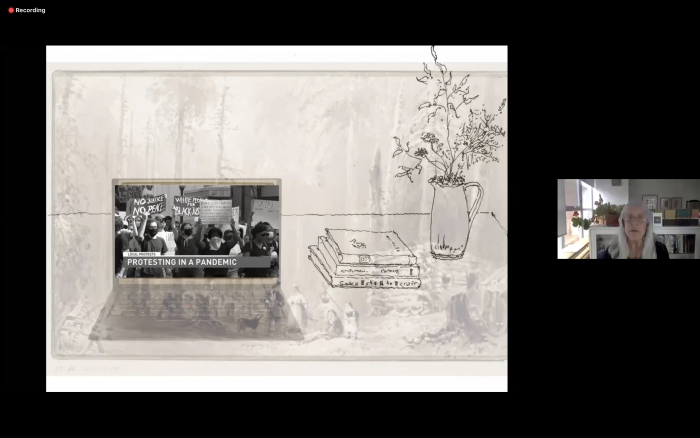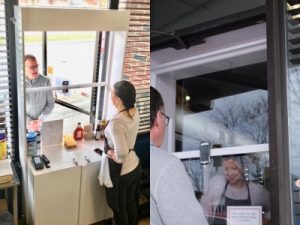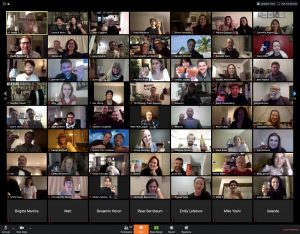Director's Project 2020: 'The fierce urgency of Now'

The Director’s Project is a one-week drawing competition with awards. Here is Azrieli School Director Jill Stoner’s introduction to the project, delivered to more than 400 students at the All School Welcome on September 9, 2020.
“We are now faced with the fact that tomorrow is today. We are confronted with the fierce urgency of Now. In this unfolding conundrum of life and history, there “is” such a thing as being too late. This is no time for apathy or complacency. This is a time for vigorous and positive action.” ― Martin Luther King Jr., March on Washington, 1963
“Well, some worlds are built on a fault line of pain, held up by nightmares. Don’t lament when those worlds fall. Rage that they were built doomed in the first place.” ― N.K. Jemisin, The Stone Sky
The ‘fierce urgency of Now’ is a phrase from Martin Luther King Jr.’s ‘March on Washington’ speech in 1963. In this paradoxical pandemic moment, we are physically isolated yet feeling that urgency to join our voices together.
This year’s Director’s Project calls upon you to engage with the language of drawing as part of a collective conversation in fraught times, as a way of “staying with the trouble.” Taken together, these drawings can be an embodiment of the current spirit of our school.
In our dense and complex world, there is no tabula rasa; there is no blank page. We start with a constructed landscape that is not neutral. By intent or by default, almost every corner of that landscape reflects economic and social inequities and an exploitation of native lands and non-human species by western ideas of progress.
Leveraging both physical and legal power, architecture, and urban development have enabled inequity to thrive. We are confronted with a lineage of racial hierarchies embedded in the paradigms of how we teach, think, and construct the architecture of our cities and towns. That same lineage has established a spatial vocabulary of disenfranchisement, its grammar constructed of zones, properties, and walls.
Laws are written in words, but also in stone. The latter suggests permanence, but acts of both building and drawing can also involve selective erasure, cutting, and fading. These acts can rewrite our spatial laws through deconstruction, revision, opening up, and clearing space. Some of these actions can be bold; others gain their power because they are subtle and almost unseen.
You will find the raw material for your drawings in three overlapping contexts.
First, you can draw upon what you have read, watched, thought, and discussed with family and friends over the past several months. You may be inspired by how the ongoing pandemic has augmented and made visible inequities in health justice, or by how Black Lives Matter protests recalibrated our urban streets. You may envision a revised spatial economics that is more equitable, perhaps less anthropocentric, and supportive of a more feral city. You may be stimulated by the unforeseen effects of the coronavirus lockdown on human footprints of pollution and consumption, or find inspiration in Indigenous knowledge practices that reject the spatial binary of city and landscape, or the temporal binary of “before” and after.”
Second, you will receive a text from your studio instructors. Find a phrase in that text that connects with what you are thinking about. Use that phrase in a literal way, as a “program” for your drawing. Part of the challenge is to incorporate the text into the drawing, to put the words on the page.
Third, you will receive a piece of a building plan or section or a fragment of a map or urban plan. This is your site. Just as we continually build on top of the already built, you will draw on top of the already drawn.
This one-week project challenges you to mobilize our unique language of drawing to “pull out” the deeper questions in our built landscape in ways that actively challenge assumptions about how architecture and urbanism operate in a complex world. Your drawings can engage overlapping concepts of negotiation, exchange, multiplicity, erasure, instability, layers, simultaneity, excavation, projection, overlap, ambiguity, adaptation, and transparency. Feel free to play loose with time and lay your vision of the future on top of the material present.
Within the context, framework, media, and methods set out by your studio instructors, explore your own ideas about ecological complexity, spatial agency, or unique intersections among the many threads of our fraught time. These drawings can be joyful. As the writer Rebecca Solnit says, there is “hope in the dark.”


